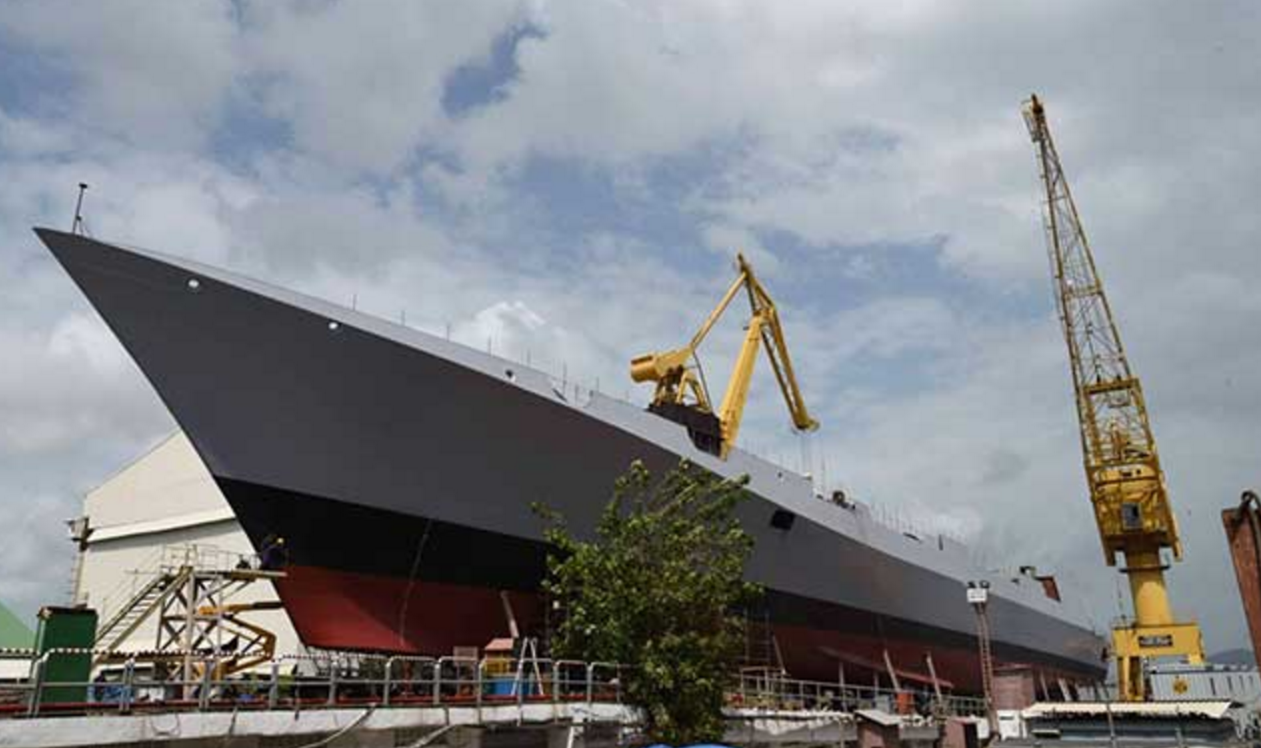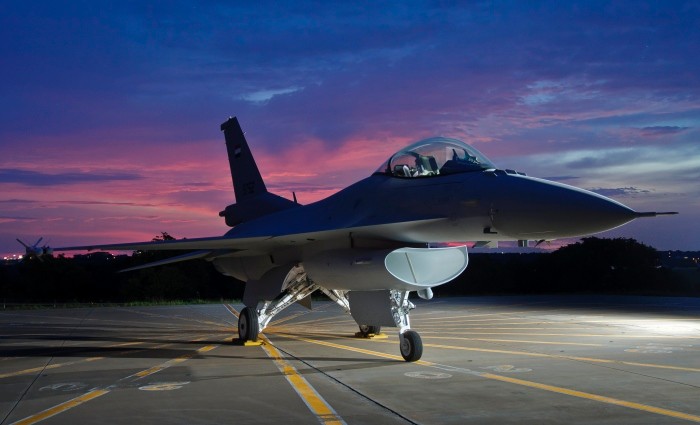2422Views 8Comments

India’s second Project 15B destroyer to be launched on Saturday
The Indian Navy’s second Visakhapatnam-class (Project 15B) destroyer, the Mormugao, is scheduled to be launched for sea trials this coming Saturday (17 September).
The Mormugao is being built by Mazagon Dock Shipbuilders Limited (MDL), which was also contracted to build the Indian Navy’s forthcoming Kalvari-class (i.e. Scorpene-class) submarines, which were ordered from France’s DCNS.
Notes, Comments & Analysis:
Project 15B is the latest iteration of the Project 15 – i.e. Delhi-class – destroyer program, which had begun in the late 1990s. The objective of the Delhi-class destroyer was to arm the Indian Navy with a robust and capable multi-mission surface warship, which was reflected in the platform’s eventual armament, which is centered on 16 Kh-35 anti-ship missiles (via quad-cell launchers) as well as a credible short and medium-range air defence system (alongside a standard 100mm main gun and other weapons).
However, the Indian Navy opted to heavily redesign the Project 15, and the result was the Kolkata-class – or Project 15A. The Kolkata-class was designed with a strong emphasis on low radar cross-section (RCS) principles, which make for reduced radar, acoustic and infrared (i.e. heat) signatures.
In addition, the Kolkata-class would begin life carrying a number of domestically sourced weapon systems, most notably the Brahmos supersonic anti-ship/surface-to-surface missile and Barak-8 medium/long-range surface-to-air missile system. This is in sharp contrast to the preceding Delhi-class, which was armed with Russian anti-air and anti-ship munitions.
The Project 15B is an iterative update of the Kolkata-class, more so than what the Kolkata-class was to the Delhi-class (which was a more significant shift). That said, the Project 15B-line of ships will see further improvements in RCS reduction as well as offensive capabilities, especially with the eventual inclusion of the Nirbhay land-attack cruise missile. The Project 15B’s lead ship, the Visakhapatnam, was launched in April of last year.



8 Comments
by MT
indigenous aesa naval radar & indian version of Aesa fire control radar are probably next two products which ll see kamorta future variants along side anti ship nirbhay missile in & around 2020( india always inducts local products in corvette/frigate first)
MF Star radar S band fire control radar ll see an indigenous version n few yrs while LW-08 thales search aesa radar is already licensed produced in india.
so in lumpsome;armaments & sensor/ communication systems ll be overtly indigenized over end of this decade.Indigenous
Pesa version of fire control radars &;search are already used in kamorta class ( irrelevant for destroyers)
The most difficult aspect of non indigenous component ll be propulsion system of which gas turbine are imported frm Ukraine while Cummins engine generators could be the another indigenous addition.
Pump and ship general purpose generators are the only indigenous component in current vishakapatnam class which are manufactured by Kirloskar group.
Bergen generators & Italian guns are not worth indigenous r&d as its almost impossible to catch up with state of art
by GhalibKabir
32 VLS for Barak may not be adequate for a war time config, at least 64 VLS Barak and 32 VLS Brahmos II/Nirbhay might be needed. I would go one step ahead and say for proper area defense IN should explore the S-300F system (with MR75 radar) to give a three tiered envelope using a 32 VLS Barak 8, 32-48 VLS S-300 and 32 VLS for AShM/LACM ala Brahmos/Nirbhay.
Most Chinese destroyers have 64 VLS minimum and with the 128 VLS type 055, we might find that IN destroyers are underarmed even if escorting frigates have 32-40 VLS themselves (the opposing navy will have frigates, missile boats etc. too). whatever be the tactics/air&naval support combo, navies might need to have a heavy load of missiles to ensure they survive battles. esp Long range AShM and LACMs
hence, the current weapon load for a 7500 ton destroyer is not adequate at all.
by MT
4-5 version of Nirbhay are under development
1. Land attack : 3 test conducted,1 successful+ 2 Failures. Flaw in diving control system mechanicsm. A low altitude test is scheduled in 2016 year end(Oct-Dec)
2. Submarine version(VLS mode from nuclear submarine): Ignition Cold Test undergone from VLS in 2015 .
A full range test may be undergone in 2017 from cold facility if GLCM Nirbhay test successfully
3. Air version: Still under development to be tested around 2018
4. Anti ship(X band seeker): Under development to be tested around 2020
5. Torpedo version(Conventional submarine):Under development to be tested around 2019-20
by Headstrong
Maybe. However, to have atleast 64 VLS, it would be necessary to standardise launch systems for both SAMs and SSMs, which has not been achieved in the Indian context – yet. But it’s getting there…
For now, given the regional context, this should suffice.
by MT
64 VLS is essential for SAM role & 32 VLS is sufficient for brahmos or Nirbhay anti ship missiles.1 Brahmos with larger conventional HE is sufficient to bring down a big target(destroyer) & can incur huge damage to a naval base
I reckon that chinese destroyers are little heavier/larger than Project 15 A & B so it ll be hard for Indian vessels to protect fleet from full fledged chinese assault
If any of you have seen Series names: “the last ship”
then you will know how those CIWS:close in weapon system are powerful enough to save ship from few incoming short range sunsonic missile attack
Indian navy also needs to rely on cheap,fully loaded, fast missile interceptor boats which should contain short range anti ship misile(small <100 KM range missile), Cheaper Indian naval SAM(lets hope we can build on Trishul missile or turn Astra AAM into naval SAM) , Italian naval gun & couple of CIWS
Such missile boat should not cost more than 50 mill$. India could build 50 of these boats with in short period of 5-10 yrs.
by GhalibKabir
Fair points. For S.Asia what you claim is true. Also, there is no UVLS yet with India that can allow for flexible missile configuration. I do understand a UVLS is in the pipeline. If I remember correctly, in the project 15 destroyers it seems like they have left a 16 cell space empty for the Nirbhay in addition to the 48 VLS Barak/Brahmos cells. Once Nirbhay tests finish we might have a 64 VLS (32 barak, 16 Brahmos and 16 Nirbhay) for a 64 loadout)
My context was for a wider regional/blue water context keeping in mind Chinese bases in Africa, Pakistan and increasing PLAN forays into the IOR. Blue water Carrier groups should ideally have cruiser class ships, destroyers, frigates, corvettes and missile boats for 360 degree ASuW, ASW, etc.
by GhalibKabir
Barring the Type 055 (10-11,000 tons full load), Chinese destroyers such as the 052D are also 7,500 tons each (same as Delhi, Kolkata and Vizag class).
To address the other point, there is no doubt that the kinetic energy packed by a supersonic cruise missile is very potent and destructive, the range of the Brahmos is too short to matter in a battle with the PLAN unless naval Tejas, P-8 or MiG 29s are going to launch them. Else, there is no way a ship is going to close enough for an attack on a PLAN battle group. The key could be if we can put in 8-cell supersonic cruise hybrid Shaurya/K-15 with a 500 kg HE warhead and use the terminal supersonic cruise missile like behavior of the Shaurya to attack Chinese Carriers and Destroyers from 500-600 km away.
The missile boats you refer to I understand are more for littoral operations in a war with Pakistan and might not matter in the Deep IOR if we ever battle China. The Sukanya class can be refitted for the same and some IN boats carry Uran AShMs and 8 cell SR SAMs which I think covers the threat of PN to a reasonable extent. that said, new Missile boats focused on ASW supplementing the kamortas wont be a bad idea IMHO. 12-24 Anti submarine ASROC type on each would help greatly.
by MT
Indian Anti ship ballistic missile program is moving swiftly but I very much double the capability of missile hitting a moving ship at large distance on hypersonic speed. You need constellation of satellites to track the enemy fleets & such missiles have almost very little time to adjust their trajectory. So probability of hitting moving target with ballistic missile is very rare.
I kindaa of believe that chinese are hyping the capability of DF21 AsBM
Has DRDO been able to test active homing devices/seekers on Agni4 or upgraded K series missiles?
K series fly at low altitude so it ll be easier for them to cruise & manoeuvre in terminal phase